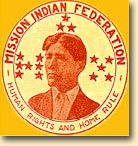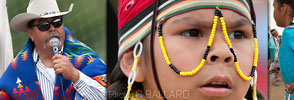
Soboba Indian Reservation
Public Law 280 Forum

By Ernie C. Salgado, Soboba Tribal Member
August 11, 2008 almost fifty-five years to the day of August 15, 1953 when Public Law 280 was implemented on all the Indian Reservations in California. It was also the same year Adam Castillo passed away. I mention this only because Mr. Castillo was not only the Tribal Chairman of the Soboba Band of Mission Indians (as it was known in the old days,) he was also the President of the Mission Indian Federation.
Some say Chairman Castillo died of a broken heart because Public Law 280 destroyed the life’s work of the Mission Indian Federation. At the meeting tribal leaders vocalizing tribal control of their reservation (Home Rule) including tribal policing of their reservations by their own people.
It has been over one hundred years since the Mission Indian Federation became politically active in 1908 and eighty-five years since fifty-seven Mission Indian Federations Tribal Leaders including one woman, were arrested by the United States Government for becoming too vocal in demanding Tribal Rights.
The Soboba Tribal Council has been in a bitter dispute over jurisdiction on the Soboba Indian Reservation. Chairman Robert Salgado has asked the Riverside County sheriffs to check in with the tribal security at the guard station before entering into the reservation, which is located approximately one mile within the reservation boundaries on Soboba Rd. The Tribal Council has given the sheriffs full access to the Tribal Casino. Chairman Salgado also said that the Tribal Council has given the sheriff full access to the reservation when in “hot pursuit” and in cases of emergency.
Riverside County Sheriff, Stanley Sniff has threatened to arrest security officers and tribal leaders who have been delaying his deputies as they attempt to enter the Soboba reservation and worries that such confrontations could escalate into violence. Chairman Salgado defended the tribe's policy of questioning sheriff's deputies when they visit the reservation, saying officials can arrest him for the practice if they want. Salgado also said he's well within his rights to have tribal security guards briefly delay sheriff's deputies who serve search warrants or conduct other business at the reservation.
Sheriff Sniff has asked federal officials to close the Soboba Casino because the continued violence on the reservation and the Tribal Council’s position of delaying his deputies as they attempt to enter the reservation poses a threat to the general public.
On August 14, 2008 members of the National Indian Gaming Commission (NIGC) visited the Soboba Casino is what they termed a routine review. Both Chairman Salgado and Sheriff Sniff have claimed responsibility for initiating the visit by the NIGC. Salgado said he asked the commission to send people from its headquarters in Washington, D.C., but the inspectors were from the Sacramento office. The results of their review have not been made public and should be forthcoming Chairman Salgado told reporters.
The Soboba Band of Luiseno Indian sponsored the P.L. 280 forum on August 11, 2008 with over 250 Tribal Leaders attending from as far as the State of Washington, Nevada, Arizona and New Mexico. In keeping with tribal traditions Jerome Salgado Sr. and his son Jerome Jr. from the Cauhilla Indian Reservation welcomed the gathering with a birdsong and Claudia Salgado, wife of Soboba Tribal Chairman, Robert J. Salgado also sang a Mountain Maidu welcoming song.
Chairman Robert J. Salgado in his welcoming told the group that the Soboba Tribe does not believe that it is above the law, but it has the right to defend its Tribal Sovereignty. He shared how he grew up with PL 280 and how the “Old Timers” would talk about how it took away the tribal rights of self-governance. He spoke of his father, Ernest Salgado Sr., who was present at the meeting at age 87 and his grandfather, O. J. Salgado who was a Charter Member of the National Congress of American Indians, and also served as Chairman for the Pechanga Band of Mission Indians, and many other tribal leaders that help form his views and opposition to PL 280. He asked the group to share their true feeling regarding P.L. 280, “…be honest, tell the truth, …” he asked. Is closing He told the gathering “…I am proud to Tribal Chairman of the Soboba Band of Luiseno Indians….”
Joe Meyers a highly respected Native American attorney shared some of his personnel experiences with law enforcement and P.L. 280. He told the Tribal Leader that P.L. 280 has not worked and it should be rescinded. It went on to say “… P.L. 280 was the bullet that was intended to kill Tribal Sovereignty as part of the “Termination Policy” of the Government…” Although the official “Termination Policy” of the Government ended with the passage of P.L. 93-638, the Indian Self Determination and Education Act of 1975 that was signed in to law by President Richard M. Nixon resistance to allowing the Tribal Governments to fully implement self governance continues at the local, state and the federal levels.
Meyers told the tribal leaders that P.L. 280 was only the beginning as it was followed by the “Reorganization and Rancheria Act” in 1958 when Indian people were told to sign the California Land Settlement and the American Dream would be theirs. The “Relocation Act” can next, which was one of the biggest disasters since the “Trail of Tears”. He compared the “Relocation Act” to the World War II Relocation Centers where nearly 120,000 Japanese and Japanese Americans were moved into 10 isolated relocation centers in Arizona, Arkansas, California, Colorado, Idaho, Utah, and Wyoming. The temporary, tar paper-covered barracks, the guard towers, and most of the barbed-wire fences are gone now, but the people who spent years of their lives in the centers will never forget them. The majority of the Tribal people that were relocated in major cities through out the nation to be training in jobs so that they could become part of the dominant society have not been able to return home as many of the Japanese were after the war.
The results of the “Relocation Act” were devastating to the traditional tribal structure families became dysfunctional resulting in poverty, alcoholism, isolation, abuse, mixed with anger, frustration and death. Tribal. Three generation later the “Urban Indians” are still faced with the stigma of a lost people. Today California has twenty percent (20%) of the total American Indian population with over 350,000 Indians living in the State.
Meyers shared a story of when he was thirteen year old when Public Law 280 came into effect and how his grandfather took great pride in making his own fishing poles and on this special day his grandfather was taking him fishing when they were stopped by two of the local game wardens. One of the game wardens told his grandfather to give him his fishing pole, which he broke over his knee and handed it back to his grandfather telling him he was no longer allowed to fish without a fishing license. He said his grand father didn’t respond he just turned around and went home. He told of how he would be woken up in the middle of the night with flashlights shinning in his eyes along with the rest of his family because the police were looking for “an Indian”. While he was sharing these experiences with the group many heads were nodding up and down as many of the Tribal Leaders in the room has also experienced similar treatment.
Carole Goldberg a professor at the UCLA School of Law and one of the leading experts on Public Law 280 told the group that she has worked with a team for the last several years conducting a national study of P.L. 280. The study compared states that have P.L. 280 with those that don’t. She held up a copy of the ten-inch thick study and said, “…At the end of the day the study showed that in the states where P.L. 280 was not implemented and the Tribal Governments conducted their own policing they were successful...” She cited the major causes for the failure of P.L. 280 was the complete breakdown of trust between tribal officials and county, state and federal law enforcement officials. She also cited the lack of communication between the Tribal Leaders and law enforcement officials, disrespect for Tribal Sovereignty and racism as major factors for the failure of P.L. 280.
She said “…Although P.L. 280 gives the jurisdictional authority of the law enforcement of criminal activity on the Indian Reservation to the States, law enforcement while carrying out this duty must honor the Constitutional Rights of the Native American people under the Fourth Amendment of the Constitutional of the United State of America…”. (Note In Mapp v Ohio, 367 U.S. 643 (1961) the Supreme Court ruled that the Fourth Amendment is applicable to the state governments by way of the Due Process Clause of the Fourteenth Amendment. The Supreme Court has said that some searches and seizures may violate the Fourth Amendment's reasonableness requirement even if a warrant is supported by probable cause and is limited in scope).
Goldberg also joined Myers in recommended the repeal of Public Law 280 but cautioned Tribal Leaders that they must have a good administrative plan for it to work. The majority of the Tribal Leaders supported the retrocession of Public Law 280 however, some expressed concern with consistence and fairness by Tribal Leaders. One example was expressed how some tribes have disenrolled tribal members and in one case a Tribal Chairman disenrolled his own father and sister. “This is why the tribe needs a strong administrative plan to avoid abuse of authority”. Goldberg told the group.
Salgado said that he would contact lawmakers and that the Soboba Tribal Council will be sending members of its Tribal Security for more advanced training so that they can carry firearms.
Jim Fletcher, Bureau of Indian Affairs Southern California Agency Superintendent said that tribes will still need to work with local law enforcement, even if they take over policing their own reservations. "We need to work together as neighbors," he said. "Sometimes we fight with our neighbors."
Riverside County Sheriff Stanley Sniff did not attend the P.L. 280 forum, but the sheriff department's new tribal liaison, Alex Tortes, attended the meeting. Tortes, is also a tribal member of the Torres-Martinez Band of Desert Cahuilla. He is a retired Lieutenant with the Riverside County Sheriffs Department. His role as the tribal liaison has not been made clear to the tribal leaders and many feel that he may be nothing more than a “Token” to appease the tribal leaders. One tribal leader said with a smile of humor ”I guess they (the sheriffs) don’t think we can communicate with non-Indians”. The afternoon session was closed to the media and was set aside for tribal discussion.
Helen Hunt Jackson wrote “A Century of Dishonor” in 1881 and one could only wonder if she was alive to day if she would pen a sequel “Two Centuries of Dishonor”.

ERNIE C. SALGADO JR

Tribal: Soboba Indian Reservation
Web Site: www.apapas.com
CONTACT
RESUME/BIOGRAPHY
Back to Ernie Salgado's Tribal Bloggers.

|







